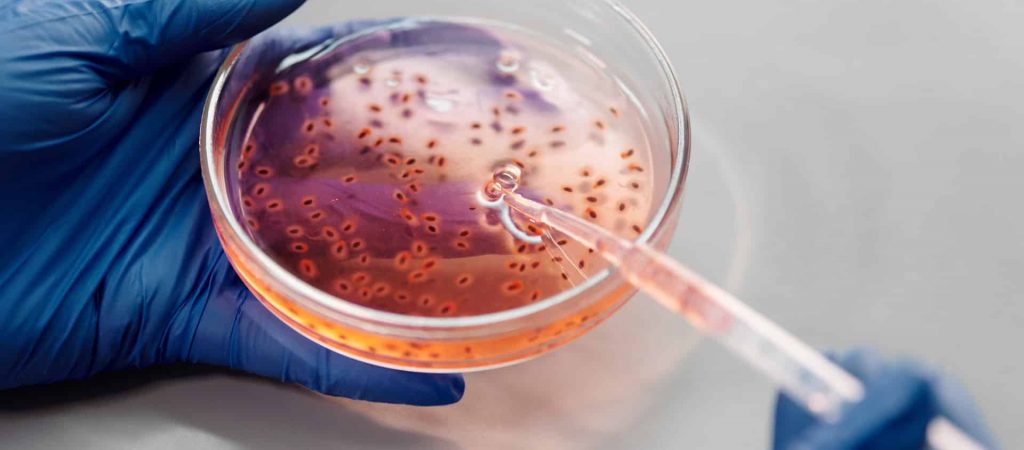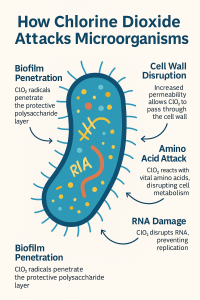
The powerful bactericide and virucide
Thanks to its unique oxidising properties and radical nature, Chlorine Dioxide (ClO₂) is one of the most effective biocides available today. It works across a wide pH range, providing reliable disinfection where traditional disinfectants fall short.
How Chlorine Dioxide Works Against Microorganisms
-
Enhanced Permeability in Alkaline Media
In alkaline conditions, the permeability of microbial cell walls increases, allowing ClO₂ radicals to penetrate more easily and reach vital cellular components. -
Disruption of Vital Cellular Functions
Chlorine Dioxide reacts with essential amino acids, disrupting metabolic processes critical for bacterial and viral survival.-
Targets disulphide bonds in proteins, damaging structural integrity.
-
Reacts with RNA, disrupting viral replication.
-
-
Effective Against Active and Inactive Microorganisms
Unlike many non‑oxidising disinfectants, ClO₂ kills microorganisms even when they are in a dormant or inactive state.-
The oxidative load imposed on cells is so strong that pathogens cannot adapt or build resistance over time.
-

Biofilm Penetration: A Key Advantage
In real‑world water systems, microorganisms rarely exist in isolation. Instead, they form biofilms: dense communities of bacteria encased in a protective polysaccharide matrix. These biofilms are notoriously difficult to remove.
-
The Problem with Biofilms
Many disinfectants are consumed by the sugars and inert compounds in the biofilm before they can reach the bacteria inside. -
The Chlorine Dioxide Difference
ClO₂ selectively penetrates the polysaccharide “glue” without being neutralised, reaching the bacteria themselves.-
Effectively destroys Pseudomonas and other biofilm‑forming bacteria.
-
Prevents regrowth by dismantling the biofilm structure entirely.
-
Improves long‑term system hygiene and efficiency.
-
Proven Effectiveness Against Resistant Pathogens
Chlorine Dioxide is among the few disinfectants proven effective against protozoan cysts such as:
-
Giardia lamblia
-
Cryptosporidium oocysts
These pathogens are resistant to many traditional chlorine‑based treatments and can cause serious illnesses such as cryptosporidiosis in public drinking water supplies.
For this reason, many modern water treatment facilities now use Chlorine Dioxide generation systems in combination with UV disinfection to achieve complete protection.
Why Resistance is Unlikely
Because ClO₂ attacks microorganisms through multiple oxidative pathways, including damage to amino acids, RNA, and protein bonds, it leaves no opportunity for pathogens to develop resistance. This gives it a major advantage over non‑oxidising disinfectants and even antibiotics.
The Bottom Line
Chlorine Dioxide delivers unmatched disinfection power:
-
Effective in a broad pH range
-
Able to penetrate and destroy biofilms
-
Proven against hard‑to‑kill protozoa
-
Virtually resistance‑proof
Whether in municipal water systems, industrial plants, or healthcare environments, ClO₂ ensures a higher level of protection, safety, and peace of mind.
ChloroKlean is the first choice for businesses considering Chlorine Dioxide. We specialise in delivering Chlorine Dioxide (ClO2) dosing systems using the latest technology and expertise.

At ChloroKlean we are always keen to be of assistance to our clients from all over the world while offering remarkable products with a time-tested customer service. Tell us what your requirements are and we will gladly help you proceed.








